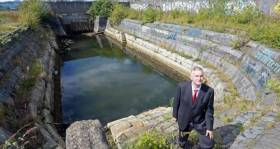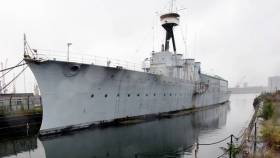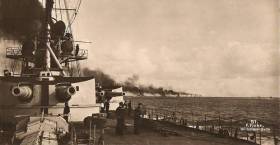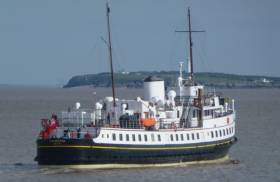Displaying items by tag: Historic Boats
#HistoricBoats- A rare example of an Irish built ship dating more than a century and listed on the UK Historic Ships Registry, is to undergo a major refit for ‘sailing’ excursions in Scotland, writes Jehan Ashmore.
The historic ship Arctic Penguin of Glasgow, was launched in 1910 originally as lightship, Penguin for the Commissioners of Irish Lights at the Dublin Drydock Company. She is built of an iron hull on a steel frame and had a fixed lantern. During her Irish Lights days she served several stations, among them at Daunt Rock. On another posting, Afloat will have more on her lightship relief duties.
It is understood the 100ft Arctic Penguin of Glasgow, which since 2010 has remained in an idle state in Inveraray on Loch Fyne in Argyll, is to go to the Ardmaleish Boatbuilding yard on the Isle of Bute. Works at the Firth of Clyde facility are also understood to be costing in the region of £1.5m. The project is so to offer tourists sailing excursion charters of the Scottish Western Isles.
The vessel now 106 years old was first old by Irish Lights 50 years ago in 1966. The new owners converted the lightship into a youth adventure sail training vessel renamed Hallowe’en.
In 1982, she was resold for the purposes of cruising as the Arctic Penguin, and converted as a fore-and aft schooner. This involved the removal of the fixed lantern and to assist sailing canvas, she was fitted with a Kelvin engine.
In her most recent guise Arctic Penguin of Glasgow was a floating Maritime Museum moored alongside Inveraray Pier, where the three master has remained. It is at this stunning location in south-west Scotland, that I paid a visit to see this unique vessel of her Irish shipbuilding heritage.
So more than a century later, the former static role of this 400 tonnes tallship is to be given a new lease of life on the cruising grounds of the stunning Western Isles and lochs of Scotland. The wonderful highland peaks that surrounds Loch Fyne and Inveraray is a major beauty spot that draws tourists and which was an added bonus when tracking down the former lightship.
Located beside the town is Inveraray Castle, seat of the Duke of Argyle, where the grounds of the estate affords views of Inverarary Pier. Also berthed here is the Eilean Eisdeal, renamed the Vital Spark to highlight the old ‘puffers’ that were the backbone of sea-borne freight trade between the isles and the mainland.
In recent times, the vessels have shifted berths at the pier which also has an outer jetty. Both structures have been closed for some time to the public by Argyll and Bute Council.
First Time in 32 Years HMS Caroline Departs Belfast Dock
#HMScaroline - For the first time in 32 years, HMS Caroline departed from its moorings in Belfast Harbour.
The Belfast Telegraph reports that the last remaining vessel from the World War One Battle of Jutland gently eased from its Alexandra Dock home yesterday (Friday) morning.
The 3,700-ton veteran light cruiser, sailed to Harland and Wolff Heavy Industries’ Belfast Dock for a scheduled hull inspection and repair.
Work is expected to last until Christmas before the ship then returns to its dock.
HMS Caroline serves as a monument to the 10,000 Irishmen who lost their lives at sea between 1914 and 1918.
Following a £15m restoration project, it opened to the public in June as a floating five-star museum and has already attracted more than 16,000 paying visitors.
For more on this rare towage operation, the newspaper features more photos click here.
#Destroyer - A UK naval destroyer was forced to cancel a visit to Belfast today, due to Russian warships understood to be bound for Syria to reinforce attacks on Aleppo, writes Jehan Ashmore.
Senior Royal Navy Officer for Northern Ireland, Commander John Gray, speaking at the 'Our Maritime Heritage' Conference held in Belfast’s Titanic Quarter yesterday, told delegates including Afloat.ie that HMS Duncan had joined a NATO flotilla in the North Sea to ‘shadow’ the Russian Navy.
HMS Duncan is the newest 'Daring' class Type 45 destroyer, which is officially affiliated with Belfast City, where Commander Gray made his comments during a talk about the restoration project of WW1 light cruiser HMS Caroline that was in the North Sea at the Battle of Jutland. The joint conference was organised by Public Record Office of Northern Ireland (PRONI).
According to the Belfast Telegraph, HMS Duncan sailed from Portsmouth on Tuesday to monitor the Kuznetsov task group in which was heading south through the North Sea and English Channel.
Theresa May has condemned Vladimir Putin's aggression in Syria as Royal Navy vessels monitored Russian warships thought to be heading to reinforce the attack on the besieged city Aleppo. The Prime Minister accused Moscow of being behind "sickening atrocities" in support of Bashar Assad's regime.
The Russian taskforce, including the aircraft carrier Admiral Kuznetsov, was being man-marked by the Royal Navy as it headed towards the eastern Mediterranean. For more the newspaper has a report here.
The fourth in a series of six Daring class destoyers built, HMS Dragon paid a visit during Cork Volvo Week in July.
We well know from running stories now and again about the restoration of the Conor O’Brien 57ft ketch Ilen at Oldcourt near Baltimore for Limerick’s Ilen Boat-building School just what a high level of interest it arouses at home and abroad writes W M Nixon. So when this Community Invitation for the decking-out ceremony in nine days time pinged through the inbox, we thought for a moment about how best to publicise it. Then the spotting of a little typo allowed us to send a pompous email telling them that the curve of the top of the hull is the sheer, but if you want to shear, then you need sheep.
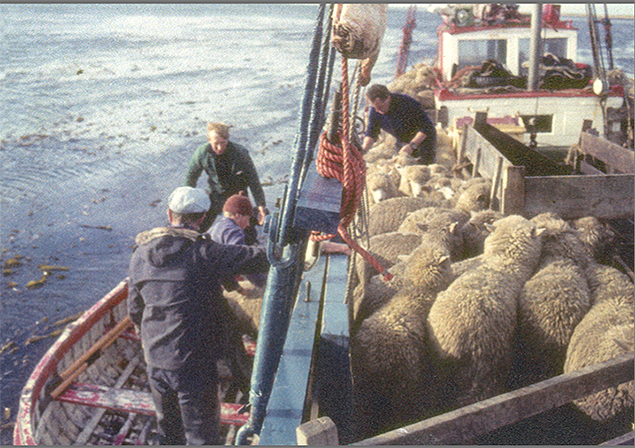 Ship sheep. Ilen takes aboard woolly passengers in her working days
Ship sheep. Ilen takes aboard woolly passengers in her working days
 Job done. After a successful shearing session, Ilen heads for home with bags of quality wool
Job done. After a successful shearing session, Ilen heads for home with bags of quality wool
You don’t pull the wool over the Limerick men’s eyes for long. Within minutes there came back the photo of Ilen’s deck well-filled with sheep during her working days in the Falkland Islands, and then another one with her foredeck topped-up with bags of wool after a successful shearing expedition.
That was followed in due course by a typo-free invite for the ceremony. It will be quite a party.
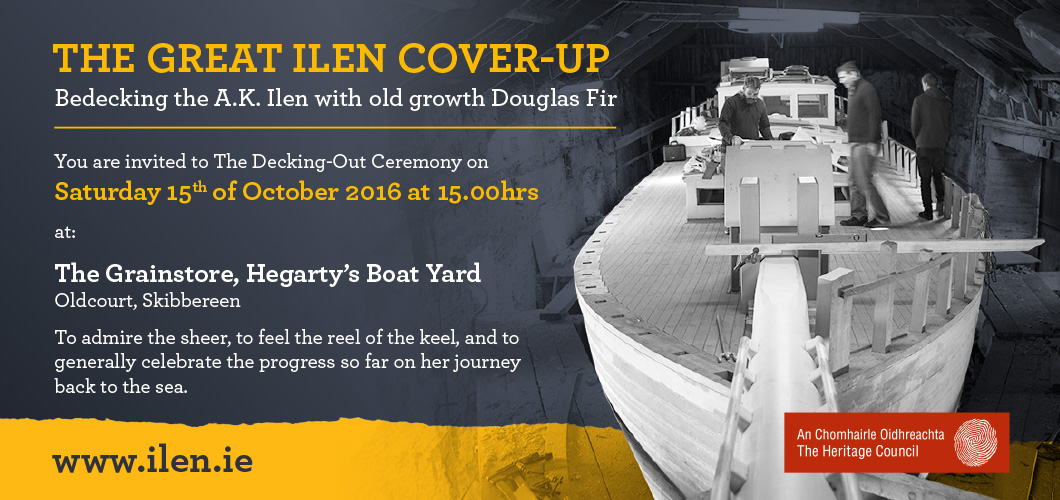 Ilen invitation all present and correct
Ilen invitation all present and correct
World’s Last Sea-Going Paddle Steamer Celebrates 70th Anniversary
#Waverley70th - P.S. Waverley, the world’s last sea-going paddle streamer built for Scottish service, which in recent decades has visited Ireland, today celebrates her 70th anniversary since launching, writes Jehan Ashmore.
The paddle steamer built in 1946 was the last of her type commissioned to serve on the Clyde (See YouTube). Since the 1970’s the magnificently preserved excursion paddler steamer with its iconic twin slanting towering funnels, timber decks, gleaming varnish and brass, has struck a chord with the public’s imagination.
This season P.S Waverley included a call to Red Bay, Co. Antrim, though the 925 passenger capacity steamer has in seasons past, included Irish ports calls along with the routine annual UK excursion season. This is mostly concentrated with trips in western Scotland.
As for her excursions along Ireland's eastern seaboard, P.S. Waverley called to Dundalk, Dublin, Dun Laoghaire, Wicklow, Arklow and as far south to Rosslare Harbour. She is featured on pages 13 and 15 of ‘Maritime’ Dalkey, a series (July 2011-July 2016) published in the Dalkey Community Council Newsletter.
It was on a short hop between Dublin and Dun Laoghaire that I had the first opportunity to sample steam-power. One could not ignore the impressive machinery available to view as those mighty engines where underway, having set off from the capitals Sir John Rogerson’s Quay bound for the harbour's Carlisle Pier.
The draw of nostalgia and for newcomers, is where Waverley Excursions provide a programme of the Glasgow based paddler. P.S Waverley explores the Lochs & Islands of the West Coast of Scotland, among them Firth of Clyde destinations to the Isle of Arran Bute and Cumbrae (see related ferry ‘Lego’ project).
According to the operator’s website, today P.S. Waverley is cruising in London along father Thames, where yesterday on the banks of the famous river the HQ of the International Maritime Organisation (IMO) held World Maritime Day along with a debate on global shipping.
#SaveDryDocks - Dublin’s Grand Canal Basin which features three Georgian drydocks writes Lorna Siggins of The Irish Times could be regenerated for theatre space, children’s recreation and marine repairs, according to a docklands business group.
The Grand Canal Basin in the heart of the capital could be “teeming with as much life and vibrancy as Dun Laoghaire is every weekend”, the Docklands Business Forum has said.
The forum, which aims to discuss its plan with Waterways Ireland today (FRI), believes that more “blue space” is imperative for the thousands of people now living and working in an area where Google and Facebook are major employers.
Cross-border agency Waterways Ireland is primarily responsible for the Grand Canal Basin and for the surrounding area where the three graving docks were constructed for vessel repair, while Nama also has a lease interest.
There have been fears among water users that Waterways Ireland wants to sell off the graving docks as a landbank for more office development.
For more on the vision proposed for the Grand Canal Basin, click here
#EnjoyNI2016 – A must see is Belfast’s newest visitor attraction HMS Caroline, a World War 1 light battle cruiser, uniquely the last survivor of the 1916 Battle of Jutland, berthed in the city’s Titantic Quarter, writes Jehan Ashmore.
The slaughter between Britain’s Royal Navy and the Imperial German Navy took place in what was the only major battle at sea of WW1, this involved 250 ships and 100,000 crew. Of course there was the land offensive, notably at the Somme, France, that began a century ago on Friday. This was marked by a major international commemoration ceremony held at Thiepval.
Among those who laid wreaths were president Micheal D. Higgins, UK prime minister, David Cameron and French president, Francois Hollande.
In May the centenary of HMS Caroline’s Jutland role was marked in Belfast and official launch following an extensive £15m plus restoration project. She was one of eight C-class light battle cruisers built in Birkenhead. Since 1924 she has been Belfast based as the Headquarters for the Royal Navy Volunteer Reserve.
Now that she is finally open to visitors, her story reveals one of the greatest naval encounters ever fought and the only clash of battleships and that of rival European powers.
Crews from throughout Ireland served the Royal Navy, they showed extraordinary bravery in not only risking but losing their lives. As visitors, it is a privilege to thread such decks of this unique battle ship, with distinct naval features of that era, the riveted hull and curvature of the bow, the tripod mast complete with look-out.
In addition those three slanting funnels, echoing the classic Transatlantic liners like that of the nearby built Titanic.
By only ‘stepping on board history’ one can begin to experience HMS Caroline as she lies afloat occupying Alexandra Dock. The lock gates of the former dry-dock that fronted onto Belfast Lough rotted away, exposing more of the port when observed at the road entrance to the visitor attraction. The location is also connected by using "The Wee Tram" within Titanic Quarter.
The role she took in the Battle of Jutland saw her among Royal Navy ships such as HMS Dublin and HMS Tipperary engaged in combat with the Germans. The outcome however ultimately led to a huge loss of life. On both sides there were more than 8,600 casualties.
Despite the British claiming victory, they suffered more losses and ships than Germans. The British blockade of Germany continued, this saw severe hardship to the population, that forced Germany into a disastrous submarine campaign which assisted to draw in the USA into the war, and eventually caused a mutiny by disillusioned German sailors in 1918.
The tour of HMS Caroline begins with a wonderful yet impactful film of the battle at sea, that really sets the tone in the dramatic build-up as the 300 crew faced the impending horrors as she entered the theatre of war. Watch the fear of her officers on the the 'open' bridge while also exposed to the natural elements. Directly below is the tiny enclosed bridge in which the self-guided tour features a ‘virtual’ version as part of the exhibits.
HMS Caroline saw action albeit she was only under fire for a mere 12 minutes! , however, the overall battle in the North Atlantic Sea raged for 36 hours. As for weapons, a pair of 6-inch guns are mounted at the bows and where eight 4-inch guns were positioned at the stern.
In close proximity are displayed the torpedoes, noting below decks are hands-on tactile displays involving replicated equipment, that form part of state of the art effects. The combination inter plays with the authentic historic restoration of the structural fabric of the ship.
She was painted in typical naval grey which remains today, though outside of Jutland duties she sported a camoflage effect, for more on this visit the onboard ‘Dazzle Zone’.
Among the interiors are the Captain’s Quarters and Marines Mess. What was notably apparent was that the dining quarters for the captain were only set for one, as the captain dined alone. There is the Signal School where you can try cracking a code using technique of semaphore and flags.
There's also the Sick Bay and Galley and that of ratings quarters be it those accommodated in cabins and that of the humble hammock.
No doubt a draw for many will be the engine rooms, complete with original replication of noise and vibrations, which really adds to the sense of been underway!
I’ve been told that if this was for real, the true level of noise would be closer to twice that experienced! Not to mention the smells and heat generated in what must have been a challenging reality during a time of war.
#Jutland100th - The last surviving Battle of Jutland naval ship provided a fitting backdrop writes the Belfast Telegraph for a commemoration honouring its centenary and all the Irish sailors who served in the First World War.
The event today at the Belfast dockside adjacent to the freshly refurbished HMS Caroline was attended by Prince Michael of Kent and a host of other dignitaries.
Read WM Nixon's blog on HMS Caroline
The memorial heard poignant testimony from a number of descendants of those who saw action on the high seas during the conflict.
On a glorious sunny afternoon, wreaths commemorating those who died were dropped by Navy officers into the relatively still waters of Belfast Lough.
The commemoration was held a day before the restored HMS Caroline will open to the public as the latest maritime-themed visitor attraction in a redeveloped dockland area that already boasts the award-winning Titanic Belfast centre.
At the close of the event, Prince Michael cut a ribbon to mark the completion of the £15 million-plus lottery-backed restoration project.
For more to read on the story click here.
#Jutland100th - Descendants of Irish sailors will gather in Belfast at Alexandra Dock on Tuesday for a commemoration marking their role during the First World War.
The event writes the Belfast Telegraph will also mark the centenary of the Battle of Jutland - and witness the official opening of HMS Caroline. The cruiser is the last remaining vessel that took part in the pivotal World War I sea battle which saw thousands of sailors lose their lives.
The Battle of Jutland involved 100,000 men in a 36-hour sea battle in which time Britain lost 14 ships and 6,000 sailors and Germany lost 11 ships and 2,500 sailors. More than 350 of the men lost were from Ireland.
Descendants of sailors from the Royal Navy and Mercantile Navy will coming from Australia, America, Canada, Spain, Britain and the rest of Ireland on May 31 for the commemoration.
The Royal Navy and Irish Naval Service will stand side by side to mark all from the island of Ireland who served at sea and wreaths will be laid. (See Afloat’s Sailing on Saturdays with WM Nixon).
Senior political and military representatives from the UK and Ireland will be in attendance, alongside a German Naval Admiral.
The ports of Ireland, Irish Lights and maritime emergency services will also gather with families of those who served, and Belfast City Council will host all attendees for a civic lunch on completion of the ceremony.
Irish Naval Service LE Ciara and the Royal Navy’s HMS Ramsey (see NATO visit to Dublin in April) will be in port this weekend and open to the public as part of Belfast's Titanic Maritime Festival as previously reported on Afloat.ie
For more on this story click here.
1916 Easter Rising Documentary ‘Troopship’ Awarded UK National Flagship of the Year 2016
#Portillos1916troopship – Excursion vessel, Balmoral, which featured on the 1916 Easter Rising documentary, ‘The Enemy Files’ presented by former British Defense Secretary Michael Portillo, has been awarded the UK’s National Flagship for 2016, writes Jehan Ashmore.
The former Conservative Cabinet minister was seen presenting the RTE documentary also broadcast on BBC, from the stern of the Bristol based excursion vessel Balmoral. The small ship acted the part of Irish Sea passenger steamer Munster which was used as a 'troopship’ for the Sherwood Foresters regiment that set off from Liverpool a century ago. The soldiers on board Munster arrived at Kingstown (Dun Laoghaire) Harbour from where they marched to fight the Irish Rebellion that was unfolding in Dublin.
Balmoral actually dates after the Rising, having been built in 1948 to operate as a ferry capable of handling up to 12 cars for Red Funnel’s Southampton-East Cowes, Isle of Wight service. From the late 1960’s the 736 tonnes vessel became a coastal excursion vessel and is currently a member of the very special list of the UK’s historic heritage fleet of vessels.
The award for the Balmoral represents a win of £500 and the honour of flying the Flagships Pennant from the masthead on her 2016 cruise voyages operated by White Funnel Ltd. Afloat adds that the season includes cruises through the Menai Straits, Anglesey, north Wales.
Martyn Heighton, Director National Historic Ships UK said about the award: I am delighted that MV Balmoral has been awarded the accolade of National Flagship of the Year. This reflects the unstinting energy and commitment that MV Balmoral Fund Ltd., its volunteers, helpers and supporters have given to this Bristol [based] ship.
Balmoral has gone through hard times having only returned to service in 2015 after an absence of two years due to essential dry-docking required to ensure a passenger certificate. The vessel is understood to be currently in dry-dock in Sharpness in preparation for the 2016 cruise season, having sailed from Bristol earlier this month.
Mr.Heighton added, it is tribute by to all concerned that not only is this ship still with us to grace the Floating Harbour, but also that the new organisation has won the confidence of the Coastal Communities Fund and other grant bodies to make her seaworthy again in order to enable her to undertake this ambitious UK-wide programme. This is a proud moment for Balmoral and her home port of Bristol.
We are of course very honoured to receive this award. It is very much a reflection on the hard work, effort and great commitment that so many people have put in to get our ship where she is today. Lots of challenges and no doubt trials and tribulations are ahead, but it really is rewarding to receive this recognition. A fitting tribute to all connected with her.






























